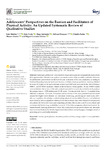Mostrar o rexistro simple do ítem
Adolescents’ Perspectives on the Barriers and Facilitators of Physical Activity: An Updated Systematic Review of Qualitative Studies
| dc.contributor.author | Martins, João | |
| dc.contributor.author | Costa, João | |
| dc.contributor.author | Sarmento, Hugo | |
| dc.contributor.author | Marques, Adilson | |
| dc.contributor.author | Farias, Cláudio | |
| dc.contributor.author | Onofre, Marcos | |
| dc.contributor.author | González Valeiro, Miguel | |
| dc.date.accessioned | 2021-06-15T16:01:21Z | |
| dc.date.available | 2021-06-15T16:01:21Z | |
| dc.date.issued | 2021-05-06 | |
| dc.identifier.citation | Martins, J.; Costa, J.; Sarmento, H.; Marques, A.; Farias, C.; Onofre, M.; Valeiro, M.G. Adolescents’ Perspectives on the Barriers and Facilitators of Physical Activity: An Updated Systematic Review of Qualitative Studies. Int. J. Environ. Res. Public Health 2021, 18, 4954. https://doi.org/10.3390/ ijerph18094954 | es_ES |
| dc.identifier.issn | 1660-4601 | |
| dc.identifier.uri | http://hdl.handle.net/2183/28087 | |
| dc.description.abstract | [Abstract] Listening to adolescents’ voices has been important to promote meaningful physical activity (PA) opportunities. Therefore, an updated systematic review of the available qualitative literature on adolescents’ perspectives on the barriers and facilitators of PA was conducted, according to Preferred Reporting Items for Systematic Reviews and Meta-Analyses guidelines. Studies published between 2014 (date of the last systematic review) and 2020 were searched in the Web of Science, EBSCO, and SCOPUS databases. Based on the inclusion criteria applied, 30 out of 8069 studies were included in the review. A thematic analysis was used to inductively and deductively analyze the perspectives of ~1250 adolescents (13–18 years). The studies took place in 13 countries from different continents. The main PA barriers and facilitators of PA were presented and discussed around five higher-order themes: (1) Individual factors (e.g., psychological—motivation, self— efficacy; cognitive—knowledge, understanding; physical—motor skills); (2) social and relational factors (family, friends, significant others); (3) PA nature factors (fun, school-based PA and physical education); (4) life factors (time and competing activities; life-course); and (5) sociocultural and environmental factors (e.g., availability/access to PA facilities, programs; urban/rural zones). By transnationally framing adolescents’ voices, this study provides updated evidence and discusses innovative implications for developing tailored interventions and pedagogical strategies aimed at promoting active and healthy lifestyles | es_ES |
| dc.language.iso | eng | es_ES |
| dc.publisher | MDPI AG | es_ES |
| dc.relation.uri | https://doi.org/10.3390/ijerph18094954 | es_ES |
| dc.rights | Atribución 4.0 Internacional (CC BY 4.0) | es_ES |
| dc.rights.uri | https://creativecommons.org/licenses/by/4.0/ | * |
| dc.subject | Exercise | es_ES |
| dc.subject | Sport | es_ES |
| dc.subject | Physical education | es_ES |
| dc.subject | Youth | es_ES |
| dc.subject | Correlates | es_ES |
| dc.subject | Young people's voices | es_ES |
| dc.subject | Qualitative synthesis | es_ES |
| dc.subject | Exercicio | es_ES |
| dc.subject | Xuventude | es_ES |
| dc.subject | Síntese cuatitativa | es_ES |
| dc.subject | Voz da xuventude | es_ES |
| dc.title | Adolescents’ Perspectives on the Barriers and Facilitators of Physical Activity: An Updated Systematic Review of Qualitative Studies | es_ES |
| dc.type | info:eu-repo/semantics/article | es_ES |
| dc.rights.access | info:eu-repo/semantics/openAccess | es_ES |
| UDC.journalTitle | International Journal of Environmental Research and Public Health | es_ES |
| UDC.volume | 18 | es_ES |
| UDC.issue | 9 | es_ES |
| dc.identifier.doi | 10.3390/ijerph18094954 |
Ficheiros no ítem
Este ítem aparece na(s) seguinte(s) colección(s)
-
GI-ESAFEX - Artigos [38]






